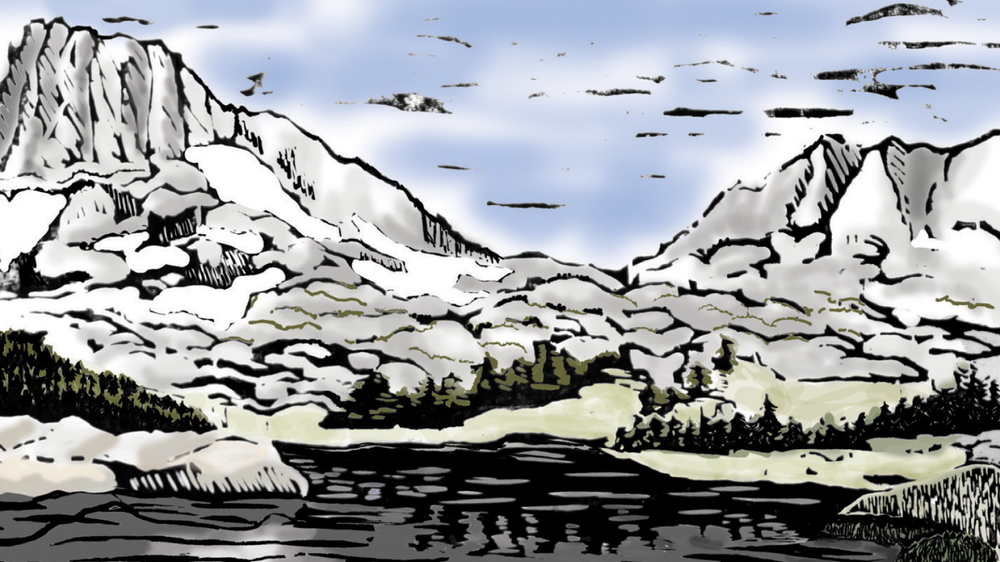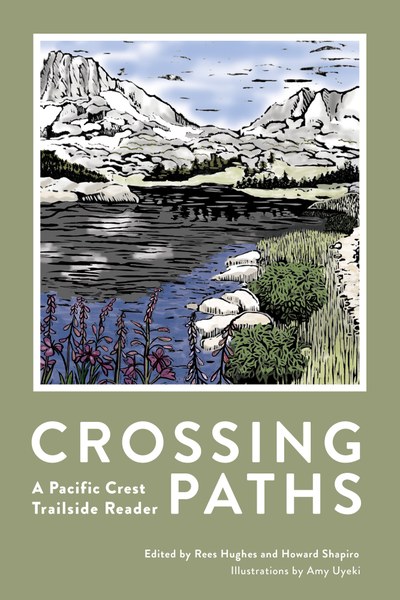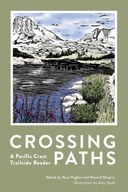
Mountaineers Books newest title, Crossing Paths: A Pacific Crest Trailside Reader, shares a diverse variety of stories from one of our nation's best-known trails. In it we hear from contributors like Cheryl Strayed, Carrot Quinn, Barney "Scout" Mann, Aspen Matis, Nicholas Kristof, Heather Anderson, Will "Akuna" Robinson, and many more.
Enjoy this sample story from the collection, "Cleansing Dirt," by Crystal Gail "The Giver" Welcome.
CLEANSING DIRT
By Crystal Gail "The Giver" Welcome
As a “Black” female, I am a rarity among backpackers. By “Black,” I mean the societal construct whereby I experience discrimination and socio-economic and a slew of other disadvantages because of how race is conceptualized in the United States. However, my skin is the color of the soil, the earth tone “raw sienna” is a more precise modifier.
I was an awkward child, often an outcast. I was made fun of and misunderstood. I found solace in running. Running was an outlet. It offered an escape and filled the void of loneliness that I felt. Running was freeing, and I loved it. Unfortunately, that love diminished as I joined team sports in high school. It continued to fade as I journeyed through early adulthood. I gradually gained weight, and at my heaviest my body had quadrupled in size. Then, in my late twenties, I developed a nonfatal rare brain disease. This was followed by a period of sadness, which turned into a deep depression. I would often lie in bed reminiscing about the more active time in my life.
After many surgeries I received a neurological implant. The implant proved beneficial, and I began running again. I ran farther and longer than I ever had before. The evening after my first half-marathon, a friend took me to a nature preserve. In that moment, with no knowledge of back-packing, hiking, or any backcountry knowledge, I made the decision to hike a trail I had only heard about. Seven months later I was at the southern terminus of the PCT.
I began my hike on April 5, 2016. Along the journey, I met hikers from all over the world, though most were from the United States. Most were experienced, with years of backcountry knowledge, with the means to take time off work, and almost all were white. I did not meet a single Black hiker on my journey. I have often heard white outdoorsmen say that there is no racism on the trail. As I grapple with this, I question why I didn’t see a single other Black person.
In the trail towns, I would have interactions with townsfolk who were pleasant enough. But I never felt the hiker welcome that other hikers seemingly received. They would socialize freely and had no need to declare themselves hikers, while I usually had to explain my reason for being in town. Once at Big Bear Lake, a guy asked me where I was hiking from. When I replied “the Mexican border,” he told me, “Wow, you speak English good” (with no sense of irony), adding, “I’m glad you made it across the border safely.”
In some ways, being on the trail was a bit of culture shock. One day, I was called “hiker trash” by a woman in her early twenties. Her smiling demeanor appeared friendly, yet the words seemed derogatory. As a Black woman, I am often a victim of the misuse of words. This term “hiker trash,” I later found out, is frequently used to signify a bona fide hiker, but I suspect being called any term followed by “trash” off-trail would be perceived as demeaning. On the trail, I encountered hikers who would down-talk my hiking gear. They would say “that’s crap” or “that’s too heavy” or “that’s not going to last.” Those interactions reminded me of my childhood growing up poor and attending an all-white school where my dad was the custodian. Sometimes the negativity was too loud. I would listen for the chickadees. They sang of joy, without expectations. They whistled about stillness and taught me about the community that surrounded me, Nature herself. I only had to connect.
I also met some really amazing folks on the trail. For example, there were three hikers from Vermont who I spent four days hiking alongside. We spent an entire day lost together, heading south during a trail closure. We hitchhiked together and had meals together. One evening, out of nowhere, it snowed. I was grateful for them. At the time, I was clueless about how to stay warm—they built a campfire that evening. And when we finally said our good-byes, they gave me Vermont maple syrup as a parting gift. We have remained friends since.
Being a solo hiker meant that even though I met people and sometimes spent time with them, I was often alone with Nature. And this was the truly amazing aspect of my trek. When I was lost, I never fretted, because I trusted that she wouldn’t lead me astray. When I felt I was running low on water, I would listen for the birds—whenever I heard them, I knew water was nearby. I would watch the clouds for evidence of shifts in weather. Instinctively, I knew the earth and was connected to the earth. The dirt was cleansing. Solo hiking felt natural, as if I had been backpacking my entire life. I understood I was safe among all things natural. The only things that could harm me were the humans, especially the ones who didn’t look like me.
One afternoon while I was headed to a Mohave campsite, I was confronted by a rattlesnake. I knew little about how to approach a rattlesnake. I was in the middle of a ridge that I couldn’t hike up or down. I didn’t want to backtrack, so my only option was to forge ahead. I thought about how I would feel if I were sleeping in my home and someone came in and woke me up. It might end in tragedy, especially with me as a Black woman. I knew I couldn’t awaken this snake, so I opted to wait it out. Time passed, and the snake didn’t wake up. I was familiar with waiting, from my experiences of growing up without: waiting for paychecks, for new shoes or new clothes. Out of respect, I decided to turn around, figuring it was a sign that I wasn’t meant to pass. As I was walking back toward the trailhead, two men came along with two llamas. They reminded me of the wise men in biblical times. They offered to help, and, as I held on to the llamas, they used my hiking poles to push the snake off the trail so we all could pass. I listened as the snake hissed in fear and anger. That night in my tent I felt the anguish of the snake. I cried—major, body-shaking sobbing that racked my body, each wail coming in a wave, and with every sob I let out a whimper. Even though the snake was not killed, we had disrupted the balance in Nature, and she cried with me. I think it may have rained twice during my nearly eight-week trek, and this was one of those times. As I cried, the rain beat against my tent. But the next morning I was greeted by the sun. I took this as a sign of forgiveness. I understood that we are all co-creators of the earth. Any harm that we do to others comes back onto us.
Toward the end of my trip I was hiking in the sweltering midday sunshine of Southern California. Apricity covered me like a cotton-lined fleece. I found myself drawn to an oddity on the trail, a Manzanita tree with a twisted trunk. My sienna complexion was reflected in the roots of the tree, a link to the earth that harmonized within me and offered peace. Its presence, its mahogany-cinnamon color in an otherwise bland landscape, served as a focal point. I was mesmerized by its aesthetically appealing weather-beaten leaves. I could tell they’d suffered, just like my ancestors. I honestly believe that a Manzanita tree can teach us more about the human condition than any textbook.
These trees exhibited strength. They survive within their means, growing not too high and not too low. They have exactly what they need to sustain themselves. They reminded me of my dad, a hardworking single father of four. He worked multiple jobs to ensure that I would have a life where I didn’t need to struggle. A life where I could hike in the California desert with no major worries or threats.
Sitting underneath the Manzanita tree, I watched as a group of white hikers passed. They provided brief salutations but no relatedness. The tree offered solidarity, and our bond strengthened. We were together in a landscape with complimentary hues—I felt I belonged there.
Like many Black people I know, Manzanitas are resilient. They are equipped with rather unusual survival mechanisms. Because we derive from nature and we are one with nature, it is important that we protect Manzanitas. But it is not only the trees and the landscape that need our protection. We must also address the injustices that systems of oppression have inflicted on Black, Indigenous, and People of Color (BIPOC). This has made it impossible for so many BIPOC to know true acceptance and the unconditional love of the Manzanita. Like nature, I believe in an inclusive and diverse outdoors where even a twisted Manzanita tree can thrive. Where a raw sienna–skinned “Black” woman can find shade, comfort, safety, and kinship in the cleansing dirt of Southern California, sitting underneath a Manzanita tree.
Find this story and many more in Crossing Paths: A Pacific Crest Trailside Reader, edited by Rees Hughes and Howard Shapiro, with illustrations by Amy Uyeki.
 Mountaineers Books
Mountaineers Books

